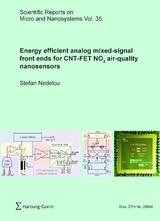Energy efficient analog mixed-signal front ends for CNT-FET NO2 air-quality nanosensors
Seiten
2022
|
2022
Hartung-Gorre (Verlag)
978-3-86628-779-2 (ISBN)
Hartung-Gorre (Verlag)
978-3-86628-779-2 (ISBN)
Alongside climate change, air pollution is one of the most concerning public health topics of the 21st century. Statistics estimate that more than seven million people die from air pollution yearly, especially in low- and middle-income countries, where people suffer from the highest exposure. Inhalable micrometer particulate matter (PM2:5 and PM10), nitrogen dioxide (NO2), ozone (O3), sulfurdioxide (SO2), and carbon monoxide (CO) are the most common pollutants, permanently monitored by World Health Organization (WHO). The six pollutants mentioned above are the main causes of a few million premature deaths annually and NO2 is one of the most important pollutants in the eye of public health. WHO’s new guidelines recommend an NO2 average level that should not exceed 107 ppb hourly, and 5 ppb annually.
This thesis tackles the NO2 monitoring problem by employing carbon nanotube field-effect transistors (CNT-FETs) as sensing elements, hence extending the ubiquitous Internet-of-Things (IoT) applications, i.e., novel air quality monitoring systems. The first prototype design proposes an embedded system that can interface up to four CNT-FETs and may expand the IoT domain for environmental and lifestyle applications. The platform performance is demonstrated using a CNT-FET nanosensor, exposed to NO2 gas concentrations from 200 ppb down to 1 ppb. The sensor signals are measured for NO2 concentrations as low as 1 ppb, achieving a 3_ limit of detection (LOD) of 23 ppb with an R2 linear fit coefficient of 0.95. Although this prototype offers custom configuration, i.e., range, bandwidth, sampling rate, acquisition time intervals, SD card, and Bluetooth Low Energy (BLE) connection, its average power consumption of 64.5mW is relatively high.
This thesis tackles the NO2 monitoring problem by employing carbon nanotube field-effect transistors (CNT-FETs) as sensing elements, hence extending the ubiquitous Internet-of-Things (IoT) applications, i.e., novel air quality monitoring systems. The first prototype design proposes an embedded system that can interface up to four CNT-FETs and may expand the IoT domain for environmental and lifestyle applications. The platform performance is demonstrated using a CNT-FET nanosensor, exposed to NO2 gas concentrations from 200 ppb down to 1 ppb. The sensor signals are measured for NO2 concentrations as low as 1 ppb, achieving a 3_ limit of detection (LOD) of 23 ppb with an R2 linear fit coefficient of 0.95. Although this prototype offers custom configuration, i.e., range, bandwidth, sampling rate, acquisition time intervals, SD card, and Bluetooth Low Energy (BLE) connection, its average power consumption of 64.5mW is relatively high.
| Erscheinungsdatum | 08.12.2022 |
|---|---|
| Reihe/Serie | Scientific Reports on Micro and Nanosystems ; 35 |
| Verlagsort | Konstanz |
| Sprache | englisch |
| Maße | 170 x 240 mm |
| Gewicht | 550 g |
| Themenwelt | Naturwissenschaften ► Physik / Astronomie ► Hochenergiephysik / Teilchenphysik |
| Schlagworte | Air Pollution • carbon nanotube field-effect transistors • NO2 • NO2 monitoring problem • Pollutants |
| ISBN-10 | 3-86628-779-8 / 3866287798 |
| ISBN-13 | 978-3-86628-779-2 / 9783866287792 |
| Zustand | Neuware |
| Haben Sie eine Frage zum Produkt? |
Mehr entdecken
aus dem Bereich
aus dem Bereich
The Biggest Ideas in the Universe
Buch | Hardcover (2024)
Dutton (Verlag)
CHF 36,15
Neue Sicht auf die Bausteine der Welt
Buch (2024)
Spektrum der Wissenschaft (Verlag)
CHF 13,70




